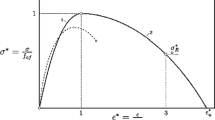Abstract
Steel fibre reinforced self-compacting concrete (SFRSCC) can combine the benefits of self-consolidating concrete technology with those derived from adding steel fibres to quasi-brittle cement based materials. In a recent applied research project joining pre-casting industry, private and public research institutions, a method was developed to design cost-competitive SFRSCC of rheological and mechanical properties required for the prefabrication of SFRSCC façade panels. To assure safe demoulding process of the panels, the influence of the concrete age on the compression behaviour of the SFRSCC should be known. For this purpose, series of tests with specimens of 12 h to 28 days were tested in order to analyze the age influence on the compressive strength, strain at peak stress, Young’s modulus, and compressive volumetric fracture energy. The experimental program was divided in two groups of test series, one with SFRSCC of a volumetric fibre percentage of 0.38% and the other with 0.57%. To apply the obtained data in the design and numerical analysis framework, the influence of the age on these SFRSCC properties was modelled. This work describes the carried out experimental program, presents and analyzes the obtained results, and provides the derived analytical expressions.
Résumé
Le béton auto-plaçant avec fibres métalliques (SFRSCC) peut combiner les avantages de la technologie de l’auto-consolidation du béton avec ceux qui résultent de l’addition de fibres métalliques aux matériaux fragiles. Dans un récent projet de recherche impliquant l’industrie de préfabrication et des institutions de recherches publiques et privées, on a développé une méthode pour obtenir du SFRSCC de coût compétitif, avec des caractéristiques rhéologiques et mécaniques requises pour la préfabrication de panneaux de façade en SFRSCC.
Afin de garantir la sécurité du processus de décoffrage des panneaux, il faut connaître l’influence de l’âge sur le comportement à la compression du SFRSCC. Ainsi, on a fait des essais avec des éprouvettes âgées de 12 heures jusqu’à 28 jours, en vue d’analyser l’influence de l’âge sur la résistance à la compression, la déformation correspondant au pic en compression, le module d’Young et l’énergie volumétrique en compression. Le programme expérimental a été divisé en deux séries d’essais portant sur des mélanges de SFRSCC de pourcentage de fibres distinct de 0,38% et 0,57% en volume. Pour appliquer les résultats obtenus dans ce projet à la conception et à l’analyse numérique, l’influence de l’âge du SFRSCC sur les caractéristiques auparavant citées a été simulée. Ce travail décrit le programme expérimental réalisé. Il présente et analyse les résultats obtenus et propose des expressions analytiques.














Similar content being viewed by others
References
Balaguru PN, Shah SP (1992) Fiber reinforced cement composites. McGraw-Hill Inc, New York
Casanova P (1996) Steel fibre reinforced concrete: from the material to the structure. Ph.D. thesis, Ecole nationale des Ponts et Chaussées (in French)
ACI 544–1R., State-of-the-art report on fiber rein-forced concrete. Technical report, American Concrete Institute, 1997
Rosenbusch J, Teutsch M (2003) Shear design with method, test and design methods for steel fibre reinforced concrete—Background and experiences. In: Schnutgen B, Vandewalle L (eds), RILEM publication PRO 31:105–118
Kodur VKR, Bisby LA (2005) Evaluation of fire endurance of concrete slabs reinforced with fibre-reinforced polymer bars. J Struct Eng 131(1):34–43
Grünewald S (2004) Performance-based design of self—compacting fibre reinforced concrete. Ph.D. thesis, TU Delft, Netherland
Carreira DJ, Chu KH (1985) Stress–strain relationship for plain concrete in compression. ACI J 82(6):797–804
CEB-FIP (1993) CEB-FIP Model Code 1990: Design code. Thomas Telford, Lausanne
Ezeldin AS, Balaguru PN (1992) Normal and high strength fibre reinforced concrete under compression. J Mater Civil Eng 4(4):415–427
Hsu LS, Hsu CT (1994) Stress–strain behaviour of steel-fibre high strength concrete. ACI Struct J 91(4):448–457
Pereira EB, Barros JAO, Cunha VMCF, Santos SPF (2005) Compression and bending behaviour of steel fibre reinforced self-compacting concrete. ConMat’05 and Mindess Symposium. In: Banthia N, Uomoto T, Bentur A, Shah SP (eds) Vancouver, p 10
LNEC E397 (1993) Concrete—Assessment of the elasticity modulus under uniaxial compression. Laboratório Nacional de Engenharia Civil, (in Portuguese).
Barros JAO (1995) Behaviour of fibre reinforced concrete, experimental and numerical analysis. Ph.D. thesis, Faculdade de Engenharia da Universidade do Porto, Portugal (in Portuguese)
Schindler AK (2004) Effect of temperature on hydration of cementicious materials. ACI Mater J 101(1):72–81
Poppe A-M, de Schutter G (2005) Cement hydration in the presence of high filler contents. Cement Concrete Res 35:2290–2299
Kooiman AG (2000) Modelling steel fibre reinforced concrete for structural design. Ph.D. thesis, TU Delft, Netherlands
EN 1992-1-1 (2004) Eurocode 2: Design of concrete structures—Part 1-1: General rules and rules for buildings. European Committee for Standardization, Brussels
Cunha VMCF, Barros JAO, Sena-Cruz JM (2006) Compression behaviour of steel fibre reinforced concrete (age influence and modelling). Technical report no. 06-DEC/E-04, Department of Civil Engineering, University of Minho, 49 pp., (URL: http://www.civil.uminho.pt/composites/Publications/2006/TR2006_001_06_DEC-E-04.pdf)
Acknowledgements
The study reported in this paper is part of the research program “Prefabricated sandwich steel fibre reinforced panels” supported by FEDER and MCT, and promoted by ADI (the funds were 45% of the applied amount). This project involves the Companies PREGAIA and CIVITEST, and the University of Minho. The authors wish to acknowledge the materials generously supplied by Bekaert (fibers), SECIL (cement), Degussa (superplasticizer), and Comital (limestone filler). The first author wishes also to acknowledge the grant SFRH/BD/18002/2004, provided by FCT.
Author information
Authors and Affiliations
Corresponding author
Rights and permissions
About this article
Cite this article
Cunha, V.M.C.F., Barros, J.A.O. & Sena-Cruz, J. Modelling the influence of age of steel fibre reinforced self-compacting concrete on its compressive behaviour. Mater Struct 41, 465–478 (2008). https://doi.org/10.1617/s11527-007-9259-4
Received:
Accepted:
Published:
Issue Date:
DOI: https://doi.org/10.1617/s11527-007-9259-4




